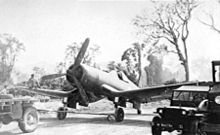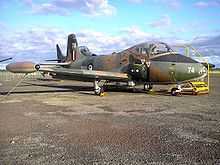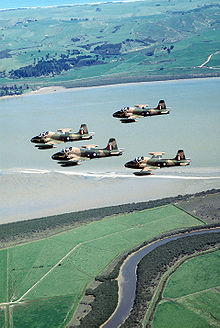- No. 14 Squadron RNZAF
-
No. 14 Squadron Royal New Zealand Air Force 
Badge of 14 Squadron RNZAFActive 25 Apr 1942 - Jan 1949
3 Sep 1951 - 13 Dec 2001Country  New Zealand
New ZealandAllegiance Queen Elizabeth II Branch  Royal New Zealand Air Force
Royal New Zealand Air ForceMotto Māori: Kia Maia , kia u, kia ngawari
(Translation: Active, ardent, adaptable)Mascot Kea Engagements World War II Insignia Squadron Badge A kea in perching position[1] Squadron Codes HQ (Apr 1942 - 1944)[2]
AX (Apr 1949 - 1950)[2]14 Squadron RNZAF was a squadron of the Royal New Zealand Air Force.
Contents
New Zealand fighters before 1941
Until World War II, New Zealand's air force concentrated on training, transport and maritime attack. The vast distance of the Pacific Ocean seemed a defence against attack by air. Until 1938, only a handful of record breaking air flights had flown to New Zealand, where they were required to land and refuel, suggesting that an enemy attack could not both get to, attack, and then return from a mission to New Zealand. The New Zealand Permanent Air Force operated token numbers of Bristol Fighters and Gloster Grebes. As far as operations overseas went, it was assumed New Zealand would be embedded within Britain's Royal Air Force. In Europe, this was the case. During the 1930s New Zealanders joined the RAF through RAF scholarships and short service commissions, like the first RAF ace of WWII, 'Cobber' Kain. In the opening years of World War II, the RNZAF produced many pilots for the RAF, including fighter pilots. Many New Zealanders trained in Canada for the RAF with the Empire Air Training Scheme. Nos 485(NZ), 486(NZ), and (later) 488 NZ fighter squadrons fought in Europe. There were however no fighter units in New Zealand itself when war broke out with Japan.
488 Squadron
In response to the rising threat from Japan, the pilots of 488(NZ) fighter squadron arrived in Singapore in November 1941, where they received Brewster Buffalos. Together with RAAF and RAF Buffalo units, including No. 453 Squadron RAAF, (which was also partly manned by New Zealanders),[citation needed] they provided the Commonwealth's only fighter force in the region. While the Japanese army advanced down Peninsular Malaysia, these squadrons fought a desperate and unsuccessful defence. The Japanese were better trained and more numerous, and as numbers dwindled, the squadrons' aircraft eventually came to be amalgamated within 488 Squadron, before in January 1942 on the eve of Singapore's surrender 488 Squadron was withdrawn to Batavia (now Jakarta) and then New Zealand.
14 Squadron forms
In 1942, the threat of attack seemed real; the city of Darwin was bombed, New Guinea invaded and Japanese reconnaissance aircraft overflew Auckland and Wellington—chased ineffectually by the RNZAF's Lewis gun-toting De Havilland Tiger Moths. The New Zealand Government hurriedly formed 488's battle-experienced pilots into the RNZAF's first fighter unit. No. 14 Squadron formed under Squadron Leader J.N. MacKenzie at Masterton on 25 April 1942, equipped with North American Harvards until P-40 Kittyhawks could be obtained.
Action against Japan
The allied plan was for the Americans to defeat the Japanese by island hopping north across the Pacific. This plan involved bypassing major Japanese bases, which would continue to operate in the allied rear. The RNZAF was given the job of operating against these bypassed Japanese units. At first, maritime patrol and bomber units moved into the Pacific, followed by 15 Squadron with Kittyhawks. In April 1943, a year after forming, 14 Squadron moved to the rear base at Santo to resume action against the Japanese.
For the remainder of the war, 14 Squadron rotated between forward and rear bases in the Pacific and 6-week periods of home leave in New Zealand. On 11 June 1943, 14 Squadron moved to the forward base of Guadalcanal—on its first contact with the enemy, the following day, six Japanese aircraft were destroyed. The five RNZAF P-40 squadrons went on to claim 99 Japanese aircraft, (subsequent, possibly partisan, research raised the figure to a round 100). No.14 Squadron claimed more than its share of the total, and one of its pilots, Geoff Fisken, became the top scoring Commonwealth ace in the Pacific (although half his victories were acquired with 243 Squadron). The squadron deployed to different bases in the South Pacific as demanded.
In November 1943, 14 Squadron moved for the first time to New Georgia, followed by Bougainville in February 1944, Green Island in December, and Emirau in July 1945. In 1944 14 Squadron became one of 13 RNZAF squadrons re-equipped with Vought F4U Corsairs, but by this time the Japanese fighters had been all but eliminated and the unit increasingly attacked ground targets. It was about to re-equip with P-51 Mustangs when Japan surrendered, and the P-51s were re-allocated to territorial units.
In March 1946, 14 Squadron went to Japan as part of the British Commonwealth Occupation Force. Concerns about breaching the terms under which the Vought F4U Corsairs were supplied resulted in plans to re-equip the unit with Supermarine Spitfire Mk. XIVs, but the United States waived these conditions, allowing 14 Squadron to take the Corsairs to Japan, where the Squadron remained until November 1948.
A P-40 flown in action by Fisken and two other New Zealand aces has been restored to flying condition and is privately owned in New Zealand.
Cyprus and Vampires
On return from Japan, the squadron briefly operated de Havilland Mosquitoes, converting pilots to the fighter bomber role. No.14 Squadron re-equipped with sixteen de Havilland Vampire jets in 1952. It was based in Cyprus from 1952 to 1955 as part of a Commonwealth peace keeping force in the area, although the unit travelled within Europe and Africa, providing a flypast on Queen Elizabeth II's accession, and being in Kenya at the time of the Mau Mau action.
A Vampire in 14 Squadron colours is preserved in the Royal New Zealand Air Force Museum's Wigram wing.
Singapore and Venoms
In May 1955 14 Squadron moved to Singapore and re-equipped with sixteen de Havilland Venoms, a development of the Vampire. No. 14 Squadron operated from Singapore against Indonesian-backed communist insurgents in what is now Malaysia until relieved by No.75 Squadron RNZAF English Electric Canberras in May 1958. A privately owned Venom still flies in 14 Squadron colours.
Ohakea and Canberras
After receiving nine B(I)12 and two T.13 English Electric Canberras at Ohakea in 1959, 14 Squadron deployed to Singapore in September 1964 to defend Singapore and Malaysia at the end of the Indonesia-Malaysia confrontation, (following in the footsteps of No. 75 Squadron RNZAF's Canberra B.2s). No 14 Squadron operated from RAF Tengah with detachments to Labuan (North Borneo) October/November 1964, RAF Gong Kedak (Malayan Peninsular) June 1965 and RAF Kai Tak (Hong Kong) October 1966. The Squadron returned to Ohakea in November 1966. The Canberras were phased out of service in July 1970 and sold to the Indian Air Force.
One Canberra is stored at Wigram awaiting restoration.
Advanced trainers
A BAC Strikemaster Mk.88 which served with 14 Squadron from 1975 to 1993. It was photographed in May 2007 at Ohakea.
No. 14 Squadron took up the role of advanced training. It briefly operated a small number (up to four) of two-seat A-4 Skyhawks and two-seat T.11 Vampires before re-equipping with 16 BAC Strikemasters in 1972. The Strikemasters were replaced by 18 Aermacchi MB 339CBs in 1991. A Strikemaster was previously displayed at the Royal New Zealand Air Force Museum's Ohakea wing, but is currently stored in the 42 Squadron hangar at Ohakea with a TA-4K Skyhawk. Five more are held in storage.
Defence minister Wayne Mapp has expressed a desire for the Aermacchi fleet to return to service, but Prime Minister John Key says it is extremely unlikely that any jet training will be restored.[3]
Disbanded
New Zealand's defence budget was pressured by involvement in East Timor, and a decade of failing to match inflationary costs. The price of maintaining fast jets was increasingly criticised by Treasury and opposition political parties. On election of a Labour government, the purchase of 28 F16s was scrapped, and the existing A4 Skyhawks and Aermacchis retired. Together with the other RNZAF fast jet units, No 14 Squadron was disbanded on 13 December 2001. A contract to sell the 17 surviving Aermacchis was signed in September 2005. The purchaser is a private US pilot training firm, which announced it will continue to operate them in their RNZAF squadron colours, sans national markings. However the deal to sell the Aermacchi trainers and also the A4-K Skyhawks fell through. They are now expected to be sold for spare or reserved as Museum pieces.[4]
References
- Notes
- ^ Halley 1988, p. 527.
- ^ a b Flintham and Thomas 2003, p. 141.
- ^ "John Key shoots down return of air strike capability". msn.nzherald.co.nz (The New Zealand Herald). 2 December 2008. http://www.nzherald.co.nz/armed-forces/news/article.cfm?c_id=123&objectid=10546026. Retrieved 16 June 2009.
- ^ "Buyer fails to meet Skyhawks deadline". msn.nzherald.co.nz (The New Zealand Herald). 6 January 2011. http://msn.nzherald.co.nz/nz/news/article.cfm?c_id=1&objectid=10698184&ref=rss. Retrieved 6 January 2011.
- Bibliography
- Ewing, Ross & MacPherson, Ross. The History of New Zealand Aviation. Auckland, New Zealand: Heinemann, 1986.
- Flintham, Vic and Andrew Thomas. Combat Codes: A full explanation and listing of British, Commonwealth and Allied air force unit codes since 1938. Shrewsbury, Shropshire, UK: Airlife Publishing Ltd., 2003. ISBN 1-84037-281-8.
- Halley, James J. The Squadrons of the Royal Air Force & Commonwealth 1918–1988. Tonbridge, Kent, UK: Air Britain (Historians) Ltd., 1988. ISBN 0-85130-164-9.
- Horn, Alex. Wings over the Pacific, The RNZAF in the Pacific Air War. Auckland, New Zealand: Random Century, 1992. ISBN 1-86941-152-8.
External links
Categories:- Royal New Zealand Air Force squadrons
- Military units and formations established in 1941
- Military units and formations disestablished in 2001
- Military units and formations of the RNZAF in World War II
Wikimedia Foundation. 2010.




